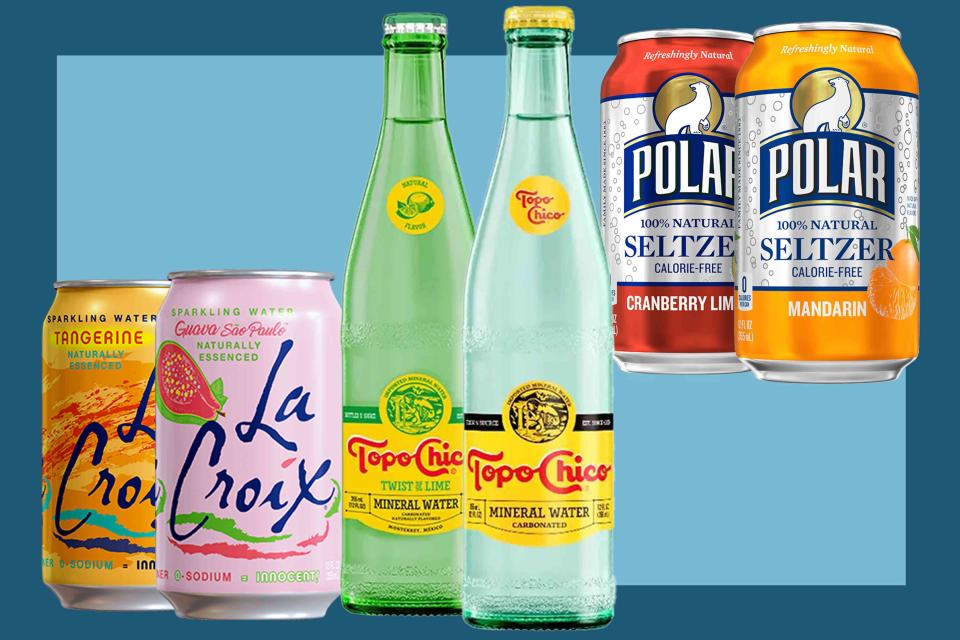Are ‘Forever Chemicals’ In Your Favorite Sparkling Water? Here’s What to Know
Many brands have PFAS levels of more than 1 part per trillion, exceeding the Environmental Working Group's recommendation.

Food & Wine / La Croix Beverages Inc. / The Coca-Cola Company / Polar Beverages
Another day, another potential toxin in one of your favorite products to worry about. This time, it’s PFAS in sparkling water.
PFAS, short for per- and poly-fluoroalkyl substances, are chemicals designed to withstand water, oil, grease, and heat, which may sound ideal for food packaging. Until you learn that these chemicals take at least a century to break down in the human body, and much longer in our environment, and like many man-made substances approved for extensive use, they’re much less safe than we thought.
Linked to cancer, autoimmune disease, thyroid problems, and more health issues, PFAS’ toxicity is worrying, and still being studied. And unfortunately, PFAS are prevalent throughout our environment, from the seafood we eat to the water we drink.
Related: How to Mitigate Your Exposure to 'Forever Chemicals' in Food, According to Experts
Bottled and canned water is often considered a healthier or safer option, thanks to purification and processing. But that may not necessarily be the case. In 2020, Consumer Reports ran a study to determine PFAS levels in 47 bottled waters, including 35 noncarbonated and 12 carbonated samples. Many of the carbonated waters had PFAS in them.
Perrier Natural Sparkling Mineral Water, La Croix Natural Sparkling Water, Canada Dry Lemon Lime Sparkling Seltzer Water, Poland Spring Zesty Lime Sparkling Water, Bubly Blackberry Sparkling Water, Polar Natural Seltzer Water, and Topo Chico Natural Mineral Water all had PFAS levels higher than 1 part per trillion. The Environmental Working Group (EWG) recommends only drinking water with less than 1 ppt of PFAS. Meaning, yes, sparkling water can be potentially problematic.
Related: This New Tool Makes Sparkling Water Easier (and Tastier) Than My SodaStream Ever Could
Luckily for seltzer drinkers, improvements can be made. After pledging to create a healthier product following the Consumer Reports study, Topo Chico halved the amount of PFAS in its sparkling water, from 9.7 parts per trillion to 3.9 parts per trillion by 2021. Still, that’s higher than the suggested intake, but it’s a start.
Seltzers are commonly believed to be healthier than sugar-packed sodas, but recent research is bringing down their cred. For many, sparkling water is a great way to hydrate and drink the water necessary for overall health. For others, sparkling water can cause gut health issues including bloating and reflux. If sparkling water triggers IBS or other digestive symptoms, it may be time to cut back on the bubble habit. Seltzers with sweeteners or additives, like artificial flavors, can also be detrimental to gut health, equivalent to, say, a Diet Coke. Something to smile about: Seltzer is healthier for your tooth enamel than soda.
Related: Chinotto Soda Is Grown-Up Diet Coke
This April, the Biden-Harris Administration announced the first-ever legally enforceable drinking water standard, in order to protect Americans from PFAS-contaminated water. And while that infrastructure project is in the works, there are a few ways you can remove PFAS from your water at home.
First, you can test your tap water with a home test kit or through a local environmental agency. If PFAS are found, you can try removing them at home. Unfortunately, boiling water to sanitize it doesn't work with forever chemicals, but Consumer Reports tested several faucet filters and a refrigerator filter to extricate PFAS from your water. From there, you can also make sparkling water at home, with a countertop soda maker.
Related: Ina Garten Eats the Same Breakfast Everyday: Toast with a Generous Schmear of This French Butter
You can’t control what’s in your bottled water, but purifying and carbonating your water at home may be the safest and healthiest option for sparkling water lovers.
For more Food & Wine news, make sure to sign up for our newsletter!
Read the original article on Food & Wine.